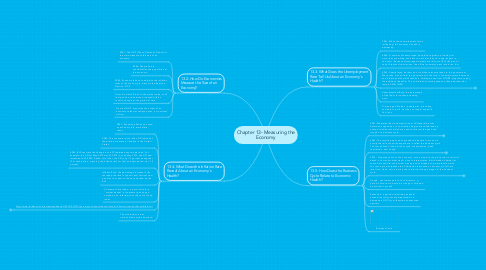Chapter 13- Measuring the Economy
by Kallin Baarstad


1. 13.2- How Do Economists Measure the Size of an Economy?
1.1. KP#1: The GDP (Gross Domestic Product) is the main measure of the size of an economy.
1.2. KP#2: They take into consideration the population of the economy.
1.3. KP#3: Economists have to adjust to the inflation rates of the economy to measure the Real and Nominal GDP.
1.4. Gross Domestic Product :the market value of all final goods and services produced within a country during a given period of time
1.5. Nominal GDP: measures the output of an economy valued at today’s prices, or in current dollars
2. 13.3- What Does the Unemployment Rate Tell Us About an Economy's Health?
2.1. KP#1: When the unemployment rate is increasing, the economy's health is decreasing.
2.2. KP#2: A number of unemployed people have given up looking for work; they are willing and able to work, but they no longer expect to find jobs. Because discouraged workers are left out of BLS (Bureau of Labor Statistics) calculations, the official unemployment rate is too low.
2.3. KP#3: Unemployed workers don't contribute income taxes to the government. Many take money from the government in the form of unemployment insurance and other benefits, which results in shifting money from OTHER programs to pay the additional benefits. This could lead to raising taxes on those workers who remain EMPLOYED.
2.3.1. Included
2.3.2. Included
2.3.3. Excluded
2.4. Unemployment Rate: the percentage of the labor force that is seeking work
2.5. Discouraged Workers: people who are willing and able to work, but they no longer expect to find jobs
3. 13.4- What Does the Inflation Rate Reveal About an Economy's Health?
3.1. KP#1: Runaway inflation can send an economy into immediate chaos.
3.2. KP#2: The consumer price index (CPI) serves as the primary measure of inflation in the United States.
3.3. KP#3: BLS can track the change in the CPI between any two periods. For example, the CPI for May 2012 was 229.815, but by May 2013, the CPI had increased to 232.945. Based off of that, the CPI rose 1.4 percent during that 12-month period, meaning the inflation rate for that one-year period was 1.4 percent.
3.4. Inflation Rate: the percentage increase in the average price level of goods and services from one month or year to the next; tracked by the BLS
3.5. Consumer Price Index: a price index for a “market basket” of consumer goods and services; also referred to as the cost-of-living index
3.6. http://www.forbes.com/sites/perianneboring/2014/02/03/if-you-want-to-know-the-real-rate-of-inflation-dont-bother-with-the-cpi/
3.6.1. This ar
3.7. The article above is an opinionated article about how
4. 13.5- How Does the Business Cycle Relate to Economic Health?
4.1. KP#1: Measures that consistently rise or fall several months before an expansion or a contraction begins are called leading economic indicators, which are used to forecast the peak and trough of a business cycle.
4.1.1. Dependencies
4.1.2. Milestones
4.2. KP#2: The recurring periods of growth and decline in economic activity that all economies experience is called the business cycle. The four phases of the business cycle are expansion, peak, contraction, and trough.
4.2.1. Schedule
4.2.2. Budget
4.3. KP#3: Negative shock to the economy, such as rapidly rising oil prices, a terrorist attack, or a stock market crash, a rise in interest rates, which makes it harder for consumers and firms to borrow money, and shortages of raw materials, which can cause price increases are all obstacles that cause an economy to fall into recession, which occurs during the contraction/trough stages of the business cycle.
4.3.1. KPI's
